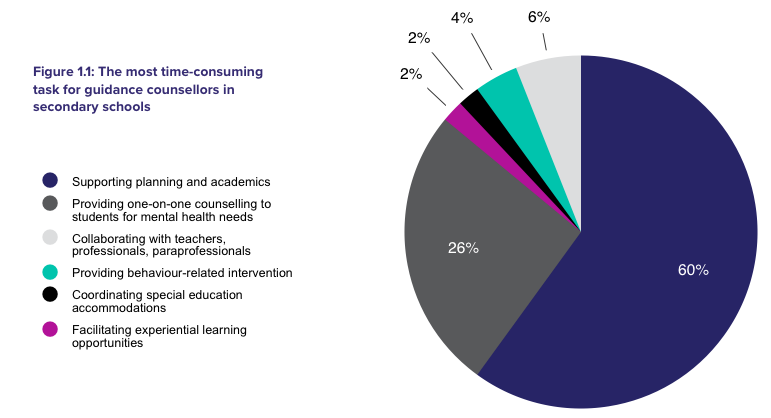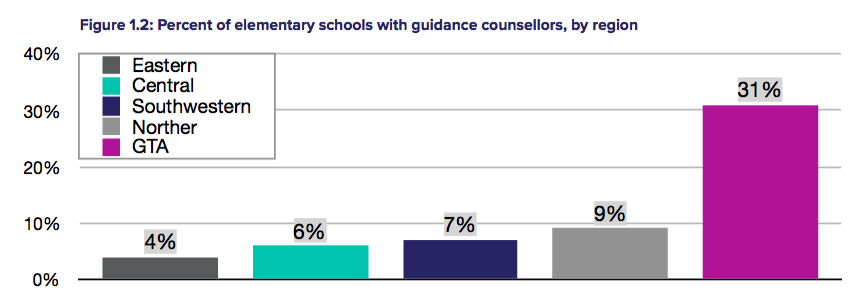This report, based on the results from our annual survey of schools, shows a disconnect between the roles that guidance counsellors are expected to fill and the amount of time they are available to fill those roles. Over 1200 schools across Ontario participated in the survey, and the findings show that the majority of elementary schools have no guidance counsellors at all, and that the ratio of students to guidance teachers in secondary schools is very high.
In 2018:
- 20% of elementary and 26% of secondary schools report that the most time-consuming part of their guidance counsellor’s job is providing one-on-one counselling to students for mental health needs.
- Among secondary schools with guidance counsellors, the average ratio of students to guidance counsellors is 396:1. In 10% of schools, this average jumps to 826:1.
- 31% of elementary schools in the Greater Toronto Area (GTA) have guidance counsellors, more than triple any other region in the province.
Guidance counsellors are a staple of secondary school staff in Ontario, and virtually every school has reported having at least part-time guidance staff. But guidance counsellors’ roles vary between schools, depending on student needs, staffing, and board/school priorities.
According to the Ontario School Counsellors’ Association (n.d.), the mission of a guidance counsellor is to support students’ well-being and growth in three areas:
- personal development,
- interpersonal development, and
- career development.
In many of Ontario’s education policies, the role of guidance staff is cited as helping students with transitions and academic programming. For example, the 2013 career and life planning policy document, Creating Pathways to Success, states that “guidance staff play a strategic role in the development and implementation of the [Pathways] program…” (Ontario, 2013a, p. 4). Guidance counsellors also play a key role in Specialist High Skills Majors (Ontario, 2016), cooperative education, and other forms of experiential learning (Ontario, 2000, p. 44).
However, guidance counsellors have other responsibilities beyond helping students determine their career paths. Guidance personnel are referenced as core members of the in-school support team in the 2010 progressive discipline document, Caring and Safe Schools (Ontario, 2010, p. 58). They are also expected to respond to student mental health issues, according to the 2013 mental health and well- being document, Supporting Minds (Ontario, 2013b pp. 93-95).
“Mental health needs are increasing at an
alarming rate and we do not have access to the professional services to truly help these students.”
– Secondary school, Kawartha Pine Ridge DSB
“Even though we have a social worker, the needs are so great that our guidance counsellor often takes on that role as well.”
– Secondary school, Wellington Catholic DSB
In 2018, many secondary school principals comment that the mental health needs of their students are a huge challenge for guidance staff.
This year, schools were asked to rank their guidance counsellor’s roles from most to least time-consuming among the following:
- Providing one-on-one counselling to students for mental health
- Supporting planning and academics (e.g. All About Me, IPPs, course
selection with students, school applications) - Collaborating with teachers, professionals, paraprofessionals (e.g. social workers, psychologists, child and youth workers)
- Providing behaviour-related interventions (e.g. classroom disruptions,
bullying) - Facilitating experiential learning opportunities (e.g. co-ops, internships,
Dual Credits) (for secondary schools only) - Coordinating special education accommodations (for secondary schools
only)
Predictably, the majority of schools report that their guidance counsellors spend more time than any other task supporting students with academic and transition planning. However, supporting students’ mental health needs was the second highest choice. Twenty-six percent of secondary and 20% of elementary schools indicate that the most time-consuming part of the guidance counsellor’s role is providing one-on-one counselling to students for mental health needs (See Figure 1.1).

This is consistent with data from 2016, when 25% of secondary schools indicated that the most time-consuming job for guidance staff was supporting student mental health issues (People for Education, 2016, p. 12).
In 2017, People for Education reported that 40% of secondary schools had regularly scheduled access to a psychologist1 (People for Education, 2017, p. 6). In the same year, half of secondary school principals reported that they did not have sufficient access to psychologists to adequately support students. When resources such as psychologists and social workers are limited, the role of guidance counsellors may be stretched to fill gaps.
We have very limited support at elementary. Many of the roles listed [in the survey question] above become duties of school administration.
— Elementary school, Simcoe Muskoka Catholic DSB
School boards receive funding for secondary school guidance counsellors at a rate of one full-time teacher for every 385 students (Ontario 2017, pp. 26-29). This ratio is reflected in this year’s results: Among secondary schools with guidance staff, the average ratio of students to guidance teachers is 396:1. However, in 10% of secondary schools this average increases to 826:1.
In elementary schools, where guidance counsellors are responsible for “providing guidance primarily to grade 7 and 8 pupils” (Ontario, 2017, p.24), school boards receive funding at a rate of one full-time guidance counsellor for every 5000 students.
In 2018, only 14% of elementary schools have guidance counsellors, and the majority are part-time. In elementary schools that include grades 7 and 8—where students are preparing to transition to secondary school—only 20% have guidance counsellors, and the majority part-time. Among elementary schools that have a guidance counsellor, they are scheduled for an average of 1.5 days per week. Principals comment that the current staffing levels are not sufficient.
Recently, the Ontario Student Trustees’ Association (OSTA-AECO) released a “student platform,” with education policy recommendations, in advance of the 2018 provincial election. These recommendations were informed by the OSTA-AECO Student Survey conducted in November, 2017. OSTA-AECO has suggested that the student to guidance counsellor ratio for elementary schools should match the ratio for secondary schools, and that the ratio of students to guidance teachers should be narrowed at both levels (OSTA- AECO, 2018, p. 5).
Because funding for guidance counsellors is provided on a per pupil basis, access to guidance counsellors in elementary schools varies markedly across the province. In the Greater Toronto Area (GTA), 31% of elementary schools have guidance staff, compared to an average of 6% across the rest of the province (see Figure 1.2).

We recommend that the province take the following actions:
- Evaluate the range of current education policies that may include guidance counsellors in order to rationalize Ontario’s guidance programs and create greater alignment across the range of policies.
- Clarify the role of both elementary and secondary school guidance counsellors in a way that recognizes both the breadth of their responsibilities and their relative scarcity in Ontario’s K-12 schools.
- Change the funding formula so that per-pupil funding for guidance counsellors is provided for students in grades 7 and 8 at the same rate as it is for secondary school students.
- Explore cost-effective ways for guidance staff supports to be expanded in small town–rural areas where they are currently lacking, compared to their urban–suburban peers.
In this document we use the term “psychologist” to include registered psychologists and registered psychological associates, as well as supervised non-registered psychology service providers in schools.
Ontario Ministry of Education. (2000). Cooperative Education and Other Forms of Experiential Learning: Policies and Procedures for Ontario Secondary Schools. Toronto, ON: Queen’s Printer for Ontario.
Ontario Ministry of Education. (2010). Caring and Safe Schools: Supporting Students with Special Education Needs through Progressive Discipline, Kindergarten to Grade 12. Toronto, ON: Queen’s Printer for Ontario.
Ontario Ministry of Education. (2013a). Creating Pathways to Success: An Education and Career/ Life Planning Program for Ontario Schools. Toronto, ON: Queen’s Printer for Ontario.
Ontario Ministry of Education. (2013b). Supporting Minds: An Educator’s Guide to Promoting Students’ Mental Health and Well-being. Toronto, ON: Queen’s Printer for Ontario.
Ontario Ministry of Education. (2016). Specialist High Skills Major: Policy and Implementation Guide. Toronto, ON: Queen’s Printer for Ontario.
Ontario Ministry of Education. (2017). Education Funding: Technical Paper, 2017-18. Toronto, ON: Queen’s Printer for Ontario.
Ontario School Counsellors’ Association. (n.d.). The Role of the Guidance Teacher-Counsellor. Hillsburgh, ON: Ontario School Counsellors’ Association.
Ontario Student Trustees’ Association (2018). A Turning Point for Education: The Student Platform. Toronto, ON: Ontario Student Trustees’ Association.
People for Education. (2016). The Geography of Opportunity – What’s Needed for Broader Student Success: People for Education Annual Report on Ontario’s Publicly Funded Schools 2016. Toronto, ON: People for Education.
People for Education. (2017). Competing priorities: People for Education annual report on Ontario’s publicly funded schools 2017. Toronto, ON: People for Education.
